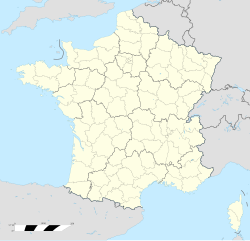纳博讷战役
此条目没有列出任何参考或来源。 (2015年2月12日) |
纳博讷战役发生于公元737年,由代表安达卢斯的塞普提曼尼亚奥玛亚哈里发国总督尤素福·阿尔-菲赫里率领的阿拉伯与柏柏尔穆斯林军队,对抗由加洛林公爵查理·马特领导的法兰克王国基督教军队[1][2][3][4]。
背景
[编辑]塞普提曼尼亚位于高卢南部,是西哥德王国尚未被征服的最后一个省份[6] 。倭马亚王朝入侵此地,目的是巩固他们在伊比利亚半岛的领土成果[6] 。719年,倭马亚军队开始进军塞普提马尼亚[6]。
该地区于719年由安达卢斯瓦利——萨姆·伊本·马利克·考拉尼率军入侵[6],并于720年被阿拉伯和柏柏尔军队占领[1][3]。纳博讷(Narbonne)改名为阿尔布纳(Arbūnah),并成为未来军事行动的基地[7]。
到721年,萨姆得到增援,准备攻打图卢兹,希望如同征服塞普提马尼亚一般攻下亚奎丹。然而,他在721年的图卢兹战役中遭遇惨败,由亚奎丹公爵伟大的奥托领军的基督徒军队击溃了穆斯林,取得关键胜利[5]。在此战役中,萨姆受重伤,最终在纳博讷身亡[5]。
在720年代,穆斯林军稳固控制纳博讷,并从海上获得补给。他们于725年攻下塞普提马尼亚西北边缘的卡尔卡松,并突袭其他城市。731年,塞尔达尼亚地区的柏柏尔领主穆努扎与奥托联盟,叛变对抗哥多华埃米尔国,但最终被白衣大食指挥官阿卜杜勒杀死。737年,查理·马特在攻下攻下亚维农后,率军围攻纳博讷[2],但无法攻克该城[4]。之后,法兰克军转向尼姆、阿格德与贝济耶进攻[2][4]。
战斗
[编辑]737年,加洛林公爵查理·马特再次进攻纳博讷[2][4] ,但当地的哥特人和高卢-罗马贵族结成军事与政治联盟[8],对抗法兰克势力扩张。尽管查理试图征服整个塞普提马尼亚,但其军队无法攻克纳博讷[2]。当阿拉伯军队从伊比利亚半岛派遣援军时,法兰克军在现今奥德省的贝尔河口成功拦截,并取得重大胜利[2][5] 。随后,法兰克军队转向攻击尼姆[2][4]。
撤退
[编辑]如果法兰克宫廷长查理·马特愿意投入军队和全部资源进行无限期围攻,他或许能够攻占纳博讷,但他不愿意或无法这样做[2]。他很可能发现阿基坦公爵霍纳德一世正在威胁他与北方的交通线。此外,普罗旺斯的贵族莫龙德从他未被征服的城市马赛,从后方发动了反抗他的叛乱[9] 。与此同时,法兰克国王还可能认为,透过摧毁塞普蒂曼尼亚的阿拉伯穆斯林军队,并将剩余的阿拉伯和柏柏尔驻军限制在纳博讷城内,他的主要目标已经实现;于是不再选择继续进攻[1]。
739年下半,查理再次发动军事行动,驱逐不再受安达卢斯支援的莫龙德,夺回马赛与普罗旺斯控制权。根据保罗执事所著的《伦巴底人史》,当穆斯林得知查理与伦巴底人结盟后,便从该地撤军,致使穆斯林军队与莫龙德势单力薄,不敢应战。
参考资料
[编辑]- ^ 1.0 1.1 1.2 1.3 1.4 1.5 Deanesly, Margaret. The Later Merovingians. A History of Early Medieval Europe: From 476–911. Routledge Library Editions: The Medieval World 1st. London and New York City: Routledge. 2019: 244–245. ISBN 9780367184582.
- ^ 2.00 2.01 2.02 2.03 2.04 2.05 2.06 2.07 2.08 2.09 2.10 Verbruggen, J. F. The Role of the Cavalry in Medieval Warfare. Rogers, Clifford J.; Bachrach, Bernard S. (编). The Journal of Medieval Military History: Volume III. Woodbridge, Suffolk: Boydell Press. 2005: 55–56. ISBN 9781846154058. doi:10.7722/j.ctt81qwd.6.
After 734 Charles Martel advanced against the nobles in Burgundy and placed the region of Marseilles under the authority of his counts. [...] Charles marched afterwards to Narbonne and sieged it. Then an army of Saracens came to relieve Narbonne. Charles marched against them and defeated them along the banks of the Berre. Charles still devastated the area around Nîmes, Agde, and Béziers, but an uprising in Saxony caused him to make an expedition to hold onto that land. [...] Charles Martel had subjected the whole of Gallia, again by battles, and had to siege Avignon and Narbonne there. He did not have the time to conquer Septimania.
- ^ 3.0 3.1 3.2 3.3 Collins, Roger. Italy and Spain, 773–801. Charlemagne. Buffalo, London and Toronto: Palgrave Macmillan/University of Toronto Press. 1998: 65–66. ISBN 978-1-349-26924-2. doi:10.1007/978-1-349-26924-2_4.
- ^ 4.0 4.1 4.2 4.3 4.4 4.5 4.6 4.7 Collins, Roger. Conquerors Divided. The Arab Conquest of Spain: 710–797. Chichester, West Sussex: Wiley-Blackwell. 1995: 92. ISBN 978-0-631-19405-7.
It would be quite anachronistic that the Provençal aristocracy would or those whose primary interests lay in the south would welcome the extension into their region of the authority of the eastern Frankish Mayors of the Palace, or that a sense of Christian solidarity should mean more than the dictates of realpolitik. For that matter it was not with any sense of obligation to free formerly Christian lands from Islamic rule that Charles Martel launched a raid into western Provence in 737. He took Avignon, but clearly did not retain it, and advanced to siege Narbonne, the centre of Arab control in the March. The Frankish chronicles record his victory over a relieving force sent by the governor ʿUqba, but their uniform silence makes it clear that despite this he failed to take the city itself.
- ^ 5.0 5.1 5.2 5.3 Baker, Patrick S. The Battle of the River Berre. Medieval Warfare (Karwansaray BV). 2013, 3 (2): 44–48. ISSN 2211-5129. JSTOR 48578218.
After three months, Eudo the Great, Duke of Aquitaine, lifted the siege. Eudo's army decimated the Moors, killed As-Sahm and drove the survivors from Aquitaine.
- ^ 6.0 6.1 6.2 6.3 Christys, Ann (2002). Christians in Al-Andalus (711-1000). London: Routledge, ISBN 0-7007-1564-9, p. 28.
- ^ Holt, P. M., Lambton, Ann K. S. and Lewis, Bernard (1977). The Cambridge History of Islam. Cambridge: Cambridge University Press. ISBN 0-521-29135-6, p. 95.
- ^ Meadows, Ian. The Arabs in Occitania. Saudi Aramco World. March–April 1993, 44: 24–29.
- ^ Lewis, Archibald R. The Development of Southern French and Catalan Society, 718–1050. Austin: University of Texas Press. 1965: 23 [June 15, 2012].


